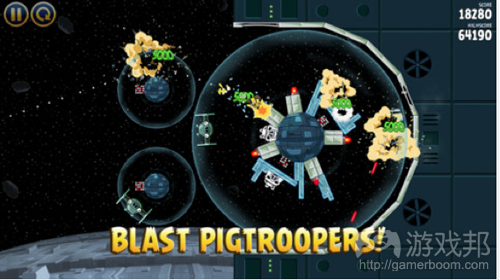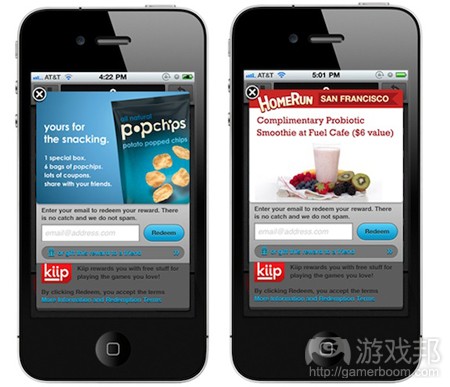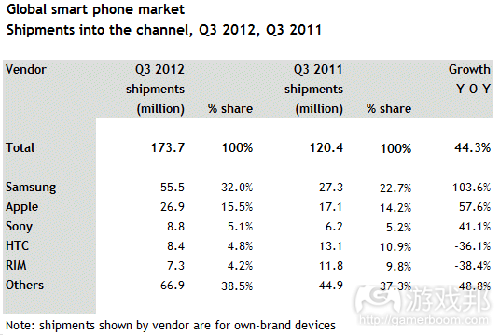每日观察:关注Rovio周边产品发展目标等消息(11.13)
1)据pocketgamer报道,Rovio日前预计公司未来数年的实体周边产品将在年收益中占据半数以上比例,食品和饮料产品是主要授权目标。
该公司首席营销官Peter Vesterbacka在日前的Open Mobile峰会上表示,Rovio将瞄准人们每天都离不开的食品和饮料,并以可口可乐模式为例,指出Rovio也能通过《愤怒的小鸟》做到这一点,但他也承认“人们会认为这个想法很疯狂”。
Rovio曾在今年8月指出《愤怒的小鸟》毛绒玩具今年销售额将双倍增长至4亿美元,并在不久前与麦当劳中国连锁店推出了基于地理定位的游戏。
2)据Techcrunch报道,Rovio最近通过一篇博文《愤怒的小鸟:星球大战》发布仅2.5小时就跻身美国App Store榜单首位。该游戏最近还在英国App Store付费应用榜单登顶,不过Rovio并未指出该游戏具体下载量,仅表示其跃居榜首的速度远超《愤怒的小鸟》之前的所有版本。
3)Simon-Kucher & Partners最近调查报告显示,半数英国智能手机用户愿意付费下载手机应用,有80%用户经常下载应用(游戏邦注:该调查样本是1000多名英国智能手机和平权电脑用户)。
调查表明,虽然游戏是最热门下载应用,但新闻应用才是使用频率最高的类型,有91%受访者曾使用新闻应用,仅有45%受访者曾体验自己在移动设备所下载的游戏。
有90%受访者曾下载游戏、办公、新闻和社交网络应用,平均每人拥有8款游戏应用,2款办公应用,2款新闻应用和2款社交网络应用。
多数愿意付费购买应用的用户表示,2英磅是其所能接受的应用售价,但也有少数用户表示可以接受单价高达70英磅的应用。
Simon-Kucher高管Annette Ehrhardt表示,这是一个积极现象,这表明应用市场并没有完全偏向“免费”领域,用户仍愿意为优质应用付费,但应用范围和类型甚为广泛,因此这里并不存在“最佳售价点”。
4)据pocketgamer报道,22Cans工作室(创始人为Peter Molyneux)最近通过公司博客呼吁粉丝捐款,以助他们为《Curiosity:What’s inside the cube》打造更出色的游戏体验。
该公司表示,无论粉丝捐款数额大小,都是在为优化《Curiosity》这款游戏出力。据报道,该游戏入驻App Store时遭遇了许多服务器问题,有些玩家无法看到游戏中盒子的实时更新状态,还有些玩家根本无法登录游戏。
但有评论者指出,22Cans号召粉丝捐款并非智举,并表示Molyneux作为许多成功游戏的行业元老,他不应该通过粉丝施舍的形式为新项目筹款。
目前该游戏仍然免费,并且没有植入任何IAP内容,不过Molyneux曾表示22Cans收集足够的数据后会考虑推出相应盈利措施。
5) RadiumOne最新报告显示,18-34岁用户群体最易于响应移动广告,这一群体是盈利性最高的品牌广告市场,其中有50%受访者会通过智能手机与好友分享广告内容,47%曾在最近三个月中点击一项移动广告内容。
与此同时,有54%受访者在过去6个月中曾通过手机进行网购,32%曾进行1-3笔交易,14%完成3-6笔交易,9%至少完成6笔交易。
报告指出有55%以上受访者每周至少一次使用移动设备针对商品货比三家,其中有33%每周有1-3次,14%每周3-6次,8%每周超过6次。
6)Canalys最近报告显示,今年第三季度机出货量达1.737亿部,同比上年增长44%。三星所占份额达32%,苹果占比15.5%,索尼则以880万部出货量跃居第三名,排名仅次于三星和苹果(游戏邦注:索尼之前已有6年时间无缘前五名)。
HTC占比4.8%,位居第四名;RIM占比4.2%,位居第五。亚太地区第三季度在全球智能手机市场中所占比例超过53%,中国市场该时期手机出货量突破5000万部。
不过Canalys数据显示不同市场的智能手机使用情况差别较大,例如9月份时iPhone应用在美国下载量占比达45%,在中国仅占比11%。(本文为游戏邦/gamerboom.com编译,拒绝任何不保留版权的转载,如需转载请联系:游戏邦)
1)Rovio: Half our revenue to come from physical goods
by Keith Andrew
Rovio has suggested it is looking to generate more than half of its annual revenue from the sale of physical goods within a few years, with food and drink products both prime targets.
That’s according to CMO Peter Vesterbacka, who revealed during an Open Mobile Summit panel that the company plans to expand on its existing lucrative merchandising set up to ensure its IP makes as much money on the real shop shelves as it does the digital ones.
Branching out
“We are looking at food, drinks, stuff that you will use everyday,” Vesterbacka told the site, citing the model of Coca Cola, who delivers a billion or so soft drinks every day.
That’s something he believes Rovio is capable of doing with Angrys Birds et al, though he admitted “people think that we are crazy.”
Existing Rovio merchandising deals are hardly few and far between. Angry Birds is already linked to everything from baby clothes to speaker sets.
Vesterbacka himself has even fronted an ad campaign for coffee in Finland, illustrating the profile the studio has built for itself.
Back in August, it was also claimed that Angry Birds plush toy sales doubled to $400 million in 2012, while Rovio has recently partnering with McDonalds in China to deliver a location-based version of the game.(source:pocketgamer)
2)Feel The Force: Angry Birds Star Wars Tops U.S. App Store In Record 2.5 Hours, Says Rovio
Natasha Lomas
Rovio’s Angry Birds Star Wars mash-up launched yesterday — and took just 2.5 hours to reach the number one spot in the U.S. App Store. In a blog announcing the figure, the games maker noted that the speed with which its latest Angry Birds incarnation rocketed to the top of the chart beat all its previous records.
The game is also currently topping the U.K. iOS App Store paid app chart.
Angry Birds Star Wars recasts the Angry Birds as plucky Rebels, battling the might of the evil Imperial Pigs across more than 80 Star Wars-themed levels.
Rovio is not breaking out actual download figures for Angry Birds Star Wars as yet, but early signs suggest its fowl-flinging cash-cow remains in rude health.(source:techcrunch)
3)50 per cent of Brits happy to pay for apps
by Daniel Gumble
Consumers use social media and news apps most of all, despite downloading more games.
Half of the UK’s smartphone consumers are more than happy to part with their hard earned pennies for an app, with 80 per cent downloading apps on a regular basis, a study by Simon-Kucher &
Partners has revealed.
Over 1,000 UK smartphone and tablet owners took part in the study, which lifted the lid on some of our app-related tendencies. The results showed that, while games apps are the most downloaded, news apps are the most used with 91 per cent of participants claiming to use them, as opposed to 45 per cent who play downloaded games on their mobile device.
Annette Ehrhardt, senior director at Simon-Kucher, believes this as a positive sign that the market isn’t moving toward an ‘everything for free’ culture, commenting: “App users are knowledgeable and willing to pay for good apps. The app range is however large, therefore there’s no one ‘optimal’ price.”
90 per cent of respondents own apps in the categories of games, productivity (functional every-day helpers), news and social networks, with respondents owning an average of eight games apps, and two each from productivity, news and social networks.
With regards to our spending habits, the average limit to what many will pay for an app is around £2. However, on rare occasions, up to £70 will be spent on an app.
Commenting on the approaches app providers can take to make the most of the UK’s app-buying habits, Ehrhardt suggests a freemium model: “Then the app can top the download listings and the provider can make money later.”(source:mobile-ent)
4)22Cans calls for Curiosity donations by ‘popular demand’
by Keith Andrew
Peter Molyneux’s 22Cans has begun accepting donations from those looking to support its iOS ‘experiment’ Curiosity – what’s inside the cube due to what it claims is “popular demand.”
Revealed via a post on the firms blog, the company claims it is looking for contributions from supports to help the game – which attracted hundreds of thousands of downloads in its first few days on the App Store – be the “best experience it can be.”
Pay to play?
“We are a small independent developer and due to popular demand we now offer the option for kind people to donate, so that we can make Curiosity the best possible experience it can be,” detailed the studio on its blog.
“However big or small the donation; it will really help us make Curiosity better.”
As detailed in the video below, players have experienced many server issues with the release, with some not seeing their cube updated in line with real time progress, while others simply can’t log on at all.
Critically speaking
Critics, however, have already claimed that the move is an unwise one, with many taking to Twitter to suggest that Molyneux – who has been behind many successful and lucrative titles in his time – shouldn’t be looking to fund his latest project via hand outs.
As things stand, Curiosity is available without charge and has no in-app purchases built in, though Molyneux recently told Pocket Gamer that the studio may look to monetise the release when enough data has been gathered from the game in its current “pure” form.
Curiosity is said to be the first in what the studios claims will be 22 experiments, each one designed to “build towards a single point.”(source:pocketgamer)
5)18-34-year-olds highly responsive to mobile ads
by Daniel Gumble
Recent study shows half of respondents will share offers via smartphones.
Branded Generation C by Nielsen and NM Incite’s U.S. Digital Consumer Report, the 18-34-year old demographic is proving to be the most receptive to mobile advertising, a recent RadiumOne study has found.
The report shows that Generation C is one of the most lucrative markets for brands to penetrate, with 50 per cent of respondents sharing offers with friends via their smartphone and 47 per cent indicating that they have clicked on a mobile ad at some point during the past three months.
Meanwhile, 54 per cent said they had made a purchase from a mobile device in the past six months, of which 32 per cent made between one and three purchases, 14 per cent between three and six, and nine per cent making six purchases or more.
Elsewhere, the report revealed that over 55 per cent of respondents used their mobile device to comparison-shop at least once per week. Of those, 33 per cent use it one-three times, 14 per cent use it three-six times and 8 per cent answered more than six.
“The results of our survey shed light into how brands can better communicate and interact with one of the most mobile and influential consumer groups of our time,” said Kamal Kaur, vice president of mobile and display at RadiumOne. “Social sharing across trusted connections and viral buzz via smartphones and tablets are extremely influential to the Gen-C population, requiring new rules of engagement between brands and this highly sought after demographic.”(source:mobile-ent)
6)18-34-year-olds highly responsive to mobile … .RIM and Nokia fall behind Sony and HTC in smartphone market
by Daniel Gumble
New products push Sony into top five for first time in six years.
As Samsung and Apple continue to exercise their stranglehold on the smartphone market, with both vendors accounting for almost 50 per cent of the market, Sony and HTC appear to have made the most significant inroads in Q3, having overtaken RIM and Nokia.
The smart phone market reached 173.7 million units during the third quarter of this year, growing 44 per cent year-on-year, according to Canalys. And having been absent from the top five for the past six years, Sony has rocketed up the rankings with 8.8 million units to occupy third place behind Apple and market leader Samsung. One of the key reasons for the brand’s resurrection appears to be the release of a host of new product in Q3, including the Xperia GX and SX.
Holding strong in fourth spot is HTC, with just under 5 per cent of the market. The vendor offered up a range of competitive products in Q2, such as the One Series and Desire V, prior to the launch of Apple’s iPhone 5. Pete Cunningham, Principal Analyst, commented: “While going head-to-head with the Samsung Galaxy S3 has been challenging, the vendor has had strong sequential growth in major developing markets, such as China and Indonesia. Q4 is going to be tough for it, along with the majority of Android- and Microsoft-based vendors, and continued investment in brand is of the utmost importance.”
RIM stayed in fifth place, while North Asia-based vendors LG, ZTE, Lenovo and Huawei all shipped impressive quantities of their own-brand devices, overtaking Nokia, as the vendor and consumers waited for the October Windows Phone 8 launch.
Asia Pacific accounted for over 53 per cent of the worldwide smart phone market. With China breaking through the 50 million unit barrier this quarter. Samsung held on to its lead in China, despite strong competition from rising local Chinese vendors. Lenovo has moved into second place, assisted by volumes of lower-priced smartphones and a focus on its routes-to-market through distribution.
“When considering actual use of smart phones, however, the markets differ dramatically again, determined by network availability, speed, pricing and localisation. For example, data from the Canalys App Interrogator tool shows that the US market still leads in terms of app downloads and revenue,” said Chris Jones, co-founder, vice president and Principal Analyst at Canalys. “For example, the US made up 45 per cent of all Apple iPhone app downloads in September, compared with just 11 per cent in China.”
Regarding USA smartphone volumes in Q3, the iPhone 5 increased Apple’s share sequentially to 38 per cent, with Samsung making up a quarter of the market. LG and Motorola followed as HTC dropped down the rankings. And, in spite of Sony’s international success, it currently holds less than 0.5 per cent market share in the US in Q3.
RIM held onto fifth place, while North Asia-based vendors LG, ZTE, Lenovo and Huawei all shipped impressive quantities of their own-brand devices. They overtook a struggling Nokia, as the vendor and consumers waited for the October Windows Phone 8 launch.
Asia Pacific accounted for over 53% of the worldwide smart phone market. China has been a powerful driver behind volumes again for many vendors and the market broke through the 50 million unit barrier this quarter. Samsung retained its lead in China, though its share has been under pressure from the rising local Chinese vendors, and remained the same as a year ago at 14%. Lenovo has moved into second place, assisted by volumes of lower-priced smart phones and a focus on its routes-to-market through distribution.
“When considering actual use of smart phones, however, the markets differ dramatically again, determined by network availability, speed, pricing and localization. For example, data from the Canalys App Interrogator tool shows that the US market still leads in terms of app downloads and revenue,” said Chris Jones, Canalys co-founder, VP and Principal Analyst. “For example, the US made up 45% of all Apple iPhone app downloads in September, compared with just 11% in China.”
For USA smart phone volumes in Q3 the iPhone 5 naturally boosted Apple’s share sequentially, to 38%, with Samsung making up a quarter of the market. LG and Motorola came next as HTC slipped down the rankings. And though Sony has had global success, it must rethink its mobility strategy in the US where it held less than 0.5 per cent market share in Q3.(source:mobile-ent)











































 闽公网安备35020302001549号
闽公网安备35020302001549号